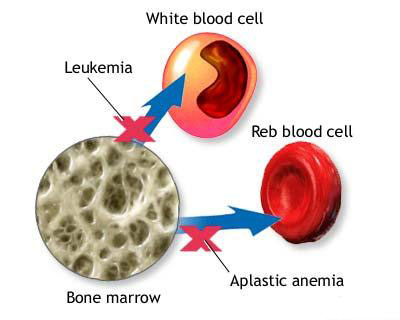Aplastic Anemia Causes, Symptoms, Diagnosis and Treatment

What Is Aplastic Anemia?
Aplastic anemia is a rare disease in which the bone marrow, and the hematopoietic stem cells that reside there, are damaged.
This causes a deficiency of all three blood cell types:
- red blood cells (anemia),
- white blood cells (leukopenia)
- Platelets (thrombocytopenia).
Aplastic refers to inability of the stem cells to generate mature blood cells.
A rare and serious condition, aplastic anemia can develop at any age. It is most prevalent in people in their teens and twenties, but is also common among the elderly.
Aplastic anemia may occur suddenly, or it can occur slowly and get worse over a long period of time.
Possible treatment for aplastic anemia may include medications, blood transfusions or a stem cell transplant.
Causes Of Aplastic Anemia:
Aplastic anemia results from damage to the blood stem cells. It develops after damage to the bone marrow.
The bone marrow may get damaged by:
- Radiation and chemotherapy treatments.
While radiation and chemotherapy targets cancerous cells, it also kills healthy stem cells in the process, thereby causing aplastic anemia. - Exposure to toxic chemicals.
Exposure to toxic chemicals
o Pesticides
o insecticides
Exposure to benzene - Use of certain drugs.
Medications used to treat rheumatoid arthritis and some antibiotics, can cause aplastic anemia. - Autoimmune disorders.
- A viral infection
Hepatitis
Epstein-Barr
Cytomegalovirus
parvovirus B19
HIV - Pregnancy.
Related to autoimmune problem - Unknown factors.
Symptoms Of Aplastic Anemia:
Aplastic anemia symptoms may include:
- Fatigue
- Shortness of breath with exertion
- Rapid or irregular heart rate
- Pale skin
- Frequent or prolonged infections
- Unexplained or easy bruising
- Nosebleeds
- bleeding gums
- Prolonged bleeding from cuts
- Skin rash
- Dizziness
- Headache
Diagnosis Of Aplastic Anemia:
The following tests and procedure help in the diagnosis of aplastic anemia:
- Blood test
- Bone marrow biopsy, to rule out other medical conditions.
In case of aplastic anemia,
Blood tests will show:
- Low red blood cell count (anemia)
- Low white blood cell count (leukopenia)
- Low reticulocyte count (reticulocyte are immature red blood cell)
- Low platelet count (thrombocytopenia)
A bone marrow biopsy will show fewer-than-normal blood cells and an increased amount of fat.
Treatment Of Aplastic Anemia:
Treatments for aplastic anemia may include:
- Observation for mild cases
- blood transfusions and medications for more-serious cases
- Bone marrow transplantation for severe cases.
Overall, the following treatment options are available;
- Blood transfusion
- Stem cell transplant
- Immunosuppressant
- Bone marrow stimulants
- Antibiotics and antiviral to fight off infections
By : Natural Health News




